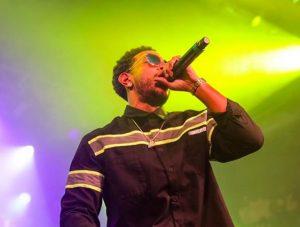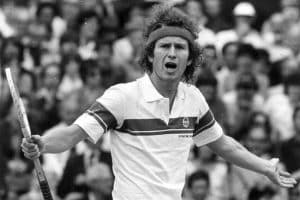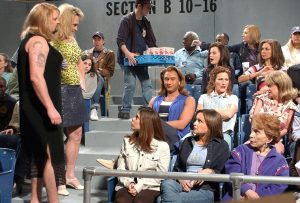“If you don’t cheat, you look like an idiot; if you cheat and don’t get caught, you look like a hero; if you cheat and get caught, you look like a dope. Put me where I belong.” – Darrell Waltrip
You’ve got your tickets for the infield lined up. You’ve got your jean shorts packed and cases of beer on ice. And you’ve got a bunch of American flags ready for your tailgate spot, obviously.
But do you know how NASCAR’S popular stock car races got their start? What’s behind that sweet neon all-caps logo? Why you’ve earned the right to booze it, holler, and rally behind your favorite driver as you inhale the sweet scent of burnt rubber? Let’s take a look at the crazy (but true) history of the sport.

Long before we ever heard the words “I just hope Dale’s okay” or learned that “Rubbin’, son, is racin’,” the original stock cars held a little something more than helmeted dudes wearing head-to-toe suits covered in logos. And they raced on roads much sketchier than the oval asphalt tracks of today.
The first drivers carried moonshine and lots of it. And crossed state lines throughout the southeast U.S. and traversing the windy country roads of Appalachia.
Flash back to the 1920s when America had the genius, totally well-thought-out idea to ban all alcohol with the passage of the 18th Amendment. In one fell swoop, the government inadvertently created an empire of black market, booze-producing entrepreneurs. Our country descended into the Prohibition era, and illegal bootlegging became the national sport. Stills popped up in the woods behind many a home in the South, and anything that could be fermented was fermented.
After the moonshine was ready and the homemade corn whiskey was ripe, all of this hooch had to make its way out from the middle-of-nowhere countryside and into the speakeasy joints and hands of those around the country awaiting their sauce. But federal agents were constantly on the lookout for these underground sources of liquor, and the bootleggers had to outdrive and outsmart the lawman.

To help moonshine runners evade authorities during transportation of those potent goods, drivers souped up their stock cars with the best available horsepower. “Stock” means that the cars looked the same as those vehicles on the dealership lot, which was a necessity for keeping their illicit business on public roads discrete.
But underneath the hood, some of these cars were equipped with the most powerful V-8 engines on the road at the time – ambulance engines. Drivers also modified their cars to give them stiffer suspension systems, which helped hide the fact that they were carrying heavy loads of liquor in addition to all that horsepower.
Needless to say, the necessity of being speedy wasn’t exactly the most boring of jobs and it leaked out into the personal lives of some of the runners. And just like any guy who’s ever spent too much money on his car, they felt the need to show off. Drivers soon began holding private, informal races against each other on these backwoods roads, public highways, and eventually, dirt tracks cut through pastures. Ya know, for bragging rights.
The man credited with the founding of NASCAR, Bill France, was an auto-repair shop owner and mechanic who’d relocated to Daytona Beach (naturally) in the 1930s. There he got involved in races and promotion which had become even more organized and popular in this seaside racing hotspot.

Big Bill just wanted to see some uniformity. These racing events had been popping up and gaining traction from Virginia to Florida, but the rules weren’t the same everywhere. France had seen one too many shady promoters bounce with the prize money before the good ol’ boys could claim it. At the end of 1947, France held a meeting with big time drivers, mechanics, car owners, and the who’s who of racing at the time. So yeah, a lot of former bootleggers were involved in the foundation of NASCAR.
These guys came up with the standardized rules for racing and a couple of months later they held the first official NASCAR race on the beach in Daytona (where else?!). Nearly all of the drivers in that race had been involved in the moonshine business in one way or another.
Junior Johnson, one of the first drivers ever inducted into the NASCAR Hall of Fame, eloquently credits his superior driving skills with his experience hauling liquor:
“When I sat down in that seat the first race I ever ran, it was a backseat to what I’d already been through. I had did all them spinning deals sideways and stuff like that. It just made my job so much easier than anybody I had seen come along and go into it.”

In 1948, the National Association for Stock Car Racing was incorporated, and finally got our acronym. Big Bill was named its prez, and the rest, as they say, is history.
In 1950, the first true NASCAR track opened in Darlington, South Carolina (hard to say “Darlington” without a southern accent, isn’t it?). And in 1979, we saw the first live television coverage of an entire NASCAR event, the Daytona 500, where an end-of-race brawl broke out on TV, boosting publicity and popularity across the nation. Hey, you can take the boys out of the country…
So even though we can now drink legally again in this great country, the speed-based sport born of bootlegging is more popular than ever. (Heck, even bootlegging didn’t stop when liquor became legal again.) NASCAR’s fame has spread from the southeastern U.S. to the rest of America and even internationally.
A day at the race is a one-of-a-kind, some might even say “cultural,” experience. Moonshine optional.





 We do not sell your information to third parties
We do not sell your information to third parties